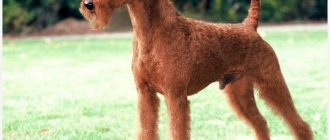The original, individual Fox Terrier breed dates back to the seventeenth century. Descriptions of the Fox Terrier breed can be found in many works. Fox terriers are also present in the first photographs. The purpose of this breed is already contained in the name itself: fox - fox. These hunting dogs were used in hunting foxes, badgers, raccoon dogs and other burrowing animals.
Video
* We invite you to watch a video about the Fox Terrier . In fact, in front of you is a playlist in which you can select and watch any of 20 videos about a given dog breed by simply clicking on the button in the upper right corner of the window. In addition, the material contains quite a lot of photos. By looking at them you can find out what a Fox Terrier looks like.
In this article:
|
Rate the material!
[Total votes: 2 Average: 3]
The Fox Terrier is an excellent companion. This breed can often be found at shows. Dogs were originally bred to hunt foxes. Nowadays, animals are practically not used for these purposes. Foxes are known for their loyalty, cheerfulness, quick intelligence, and restlessness. The name comes from the words “fox” (fox) and “terra” (earth).
Breed classes
Fox terriers are typically divided into three classes.
The lowest class consists of puppies and dogs from purebred parents, who have small non-pedigreed characteristics and nuances that are noticeable only to specialists. These dogs are cheaper and can become wonderful companions and family members.
The middle class are dogs with a pedigree from purebred parents who are suitable for display at exhibitions, but do not have excellent characteristics to become champions.
And the highest class is dogs and puppies that have the best characteristics. They are used to improve the breed, bred, and female dogs give birth to puppies.
They need special attention and a lot of time, so if the owner is not interested in developing the breed, it is better to choose from the first two classes. The price of fox terrier puppies also fluctuates according to the classes.
History of the origin of fox terriers
The birthplace of the breed is considered to be Great Britain. English hunters brought her out to catch foxes. The ancestor of dogs, crossed with a black and tan terrier, endowed modern individuals with energy, endurance, and self-confidence. The breed is divided into two subspecies - smooth-haired and wire-haired.
Interesting fact: The first mentions of the then four-legged animals date back to the 50s BC. Pliny the Elder in his story “Natural History” wrote that Caesar and his subjects arrived in the lands of Albion and saw small dogs hunting for game in holes. Marco Polo in his work mentioned small terriers, which were especially valued by the Great Khan.
The breed was first described by the English physician John Caius in 1570. James I wrote to Lord Caldwell that he admired earth dogs. Since then, a new type of dog has been added to the history of dog breeding. The modern Fox Terrier combines the English Foxhound, Dashhound and Hound breeds. The standard for the Smooth Terrier was established in 1876.
At that time, the British were very fond of sporting events, and terriers were valued both among the nobility and among the poor. Millers kept animals to catch rats. In the evenings in the British Isles, artisans released their pets and bet on whose dog could kill the most rodents in a certain time.
Writer T.H. Scott mentioned in one of his works that his pet chased prey into a hole and did not come out for several hours. When the owner became concerned and dug up the ground, he discovered the animal in a fight with raccoons. Although the pet was severely bitten, he still did not intend to retreat.
Despite the fact that representatives of the breed have not lost their hunting skills to this day, now they are more often considered as decorative dogs. Participation in exhibitions slightly deprived them of their former courage, but such qualities as friendliness and sociability increased.
Description
Males should not exceed 15 ½ inches or 39.37 cm at the withers, females slightly less. Males weigh about 8 kilograms, females about 7 kg.
The main color is white, it can have spots of any color, with the exception of brindle, red or brown. Common colors: white with reddish-brown, black and tan (saddleback) or black spots. The fur is thick and covers the belly and the inside of the paws. They feel hard and thick to the touch, but at the same time smooth.
The eyes are round, deep-set with a playful expression and playful sparkles. They are dark in color and quite small. The ears are small, V-shaped, hanging. Prick ears are highly undesirable.
Fox Terrier - description of the breed
After official recognition, they decided to divide the breed into two types: smooth-haired and wire-haired. The standard for both types remains the same. Previously, preference was given to smooth-haired quadrupeds. They were considered elite dogs.
Large individuals were assessed as rejects and did not participate in breeding. This decision led to a new type with a narrow head, small ears and an elongated neck. Modern specimens have narrower shoulders and less distance between the shoulder blades. Wire-haired animals are now more popular and outnumber the second type.
Quadrupeds are endowed with good physical strength. They are capable of attacking an enemy many times larger than their own size. Dogs have fearlessness and, to some extent, even recklessness. They have a good physique and an elegant appearance.
The breed standard for smooth coated terriers is determined by the following parameters:
- Male weight: 7.3-8.2 kg;
- The weight of the bitches is 6.8-7.7 kg.
The ideal parameters of wire-haired individuals competing for exhibition awards are no more than 8.25 kg and no higher than 39 cm at the withers. The eyes are small, deep-set, round. The ears are triangular in shape and hang down to the cheeks. There is a smooth transition from the forehead to the muzzle.
Interesting fact: The length of the body is proportional to the height. Despite their compact size, Foxes give the impression of strong dogs. The powerful neck widens towards the shoulders. The back is short but strong. The chest is deep. The tail is set high and straight. The paws are round and small. The limbs are muscular and strong.
The congenital stance looks very aesthetically pleasing. The body is directed forward, like an athlete about to start. Even if the dog stands still, it seems that he is about to take off and run, trying not to touch the ground with his paws.
Breed standard Wire Fox Terrier
Initially there was no division into separate breeds. Wire-haired and smooth-haired dogs crossed with each other, achieving ideal hunting qualities. Over time, two types of fox terriers were identified, and the differences between them were only in the structure and length of the coat. Also, the FCI standard allows solid white color only in smooth-haired dogs.
Height at withers: up to 39 cm. Ideal weight: 8.25 kg.
- Color: black or red spots on a white background.
- Eye color: dark brown.
- Nose color: black.
- General appearance: Well balanced dogs with a coarse coat and a strong build.
Are the American Toy Fox Terrier and the Jack Russell Terrier related?
In the 30s of the 20th century, enthusiasts from the USA developed a new breed - the American Toy Fox Terrier. In the AKS system, they achieved recognition and approval of the standard in 2003. This breed owes its origin to fox terriers from Europe. To obtain miniature sizes, the blood of English hunters was massively infused with the blood of Chihuahuas, Italian greyhounds and miniature pinschers. Today, the Amertoi (the short name adopted by the AKC) is considered a decorative dog with good health.
The Jack Russell Terrier is a variety of the old-type fox terrier that existed before the beginning of the 20th century. The creator of the Jack Russell breed was concerned with creating a terrier with increased viciousness. It is believed that English Bull and Dogs were mixed with the old type Foxes.
Popular Fox Terrier colors
The International Canine Association divides smooth-haired and wire-haired species into different breeds precisely because of the condition of their coats.
Regardless of its type, the color of four-legged animals can be of two options:
- Bicolor - white with red spots;
- Tricolor - red and black spots on a white background.
Any other colors are considered a deviation from the standard.
Each variety has its own characteristic color:
- Goldwing vd Schonen Bergen - tri-color with a predominance of white;
- Afterall Painting The Sky - wire-haired, white and red in color;
- Gothic Cloak and Dagger are a tri-color color. For both varieties, the standard provides for the predominance of white and black colors, but they are almost never found in this form. These dogs have a slight tan, making them tri-colored. White individuals have small spots or speckles;
- Dono Vtia Don't Worry Be Happy - white and tan.
The coat is hard and thick. The hair lies tightly to the body. There is also thick fur on the belly and inner thighs. Shades may vary, but the main color is white. There are individuals with bright red streaks. They are called brindle and are considered undesirable.
Interesting fact: Wire-haired dogs have wavy, curled hair with a thick undercoat. They look more presentable than their counterparts and do not shed. Such individuals need haircuts and frequent combing. On the chin the hair is longer and forms a beard.
The hair of the Smooth Fox is straight and short. Their appearance is considered more refined and sophisticated. On the stomach and inner thighs the hair is shorter, but without bald patches. Special care is not required for such individuals, but be prepared for the fact that fur will be not only on your pet, but also on furniture, carpet, and clothes.
Tips for choosing a puppy
When thinking about buying a fox terrier, decide whether you need a show or a hunting specimen. There are separate nurseries for breeding each of the two lines of this breed. Already there they monitor the exhibition or hunting qualities of fox terrier puppies.
Ask the breeder to show the pedigree of the parents and baby. Look at their appearance, working qualities, and compliance with breed standards.
The best age to choose a puppy is 1.5-2 months. It is not worth buying a younger specimen. The price may be lower, but it will not be possible to detect birth defects.
A docked tail in the first days of a quadruped’s life is an important part of the breed standard. There is no point in buying a Fox with a whole tail. When baiting an animal, this part of the body can be damaged. For exhibition representatives, such a violation makes it impossible for the animal to participate in shows in the ring.
Character and habits of fox terriers
By their temperament, animals are energetic, active, and alert. They are distinguished by their observation and quarrelsome character. A leash will help contain your pet's mischief, because a fox can break free at any moment and run after a cat that flashes into view or rush after a car.
Any self-respecting fox terrier will not miss the opportunity to start a fight. Together with bull terriers, pit bulls and Caucasian shepherd dogs, they occupy the top places in the ranking of the most aggressive breeds. In fights, they often use a “death grip” and, in order to loosen it, the owner has to engage in long persuasion.
Interesting fact: Despite their explosive nature, dogs are friendly and obedient at home. They relate well to children and are happy to accompany them in any undertaking. Although pets adapt well to urban conditions and living in an apartment, life in a private home is more suitable for them. Dogs have good health and immunity.
Foxes quickly respond to their owner's commands. If they froze and stared motionlessly somewhere, it means they saw something and are now going to rush somewhere. Lightning-fast reaction combined with fast and sharp movements. It is extremely difficult to instill calm in these four-legged animals. They are difficult to train because they are constantly on the move.
Dogs' sociability can be a problem for busy owners. If the dog feels indifference on the part of the owner, he will definitely express his dissatisfaction in an aggressive manner. Also, if he doesn’t like something, the four-legged animal will growl at its owner without a twinge of conscience and will resist in case of punishment.
Pets love to bark and make noise for no reason. They are vindictive. Despite being friendly towards children, if a child offends the dog, he will respond in kind. The more energy your pet spends outside, the more docile he will behave in the apartment. In your own home, it is better to allocate a separate sector for him so that he does not dig up the entire territory.
Dog character traits
It is not for nothing that the purebred fox terrier is compared to a true English gentleman. He combines amazing fearlessness and friendliness; temperament and aristocracy; comical appearance and grace. Looking at the dog, one feels that his gaze reveals a remarkable intelligence and ebullient energy.
The standing Fox Terrier is a classic example of a hunting dog. A graceful, tense posture indicates that the dog is concentrating on the task at hand. Her reaction is lightning fast, and she can move at high speed. The Fox Terrier has a very lively temperament - he is ready to frolic at the slightest opportunity, and reacts to any action of the owner.
Fox Terriers are quite intelligent and understanding animals, but their upbringing is hampered by a fair amount of stubbornness and independence. They are able to quickly and accurately execute any commands, but there must be incentive and interest for this, and the owner’s desire does not always coincide with the desire of his pet.
In general, Fox Terriers are friendly and loyal. If a common language is found, it is pleasant to communicate with them, and they become true friends. But it should be remembered that they are ready to instantly respond to any aggression with even greater aggression, and they are not lacking in fearlessness. In addition, fox terriers are characterized by intolerance to actions that they do not like - they are able to growl even at the owner if something undesirable for the dog is visible in his actions. The Fox Terrier does not accept physical punishment and resists by any means.
Certain problems with the Fox Terrier may arise during a walk. Indomitable energy sometimes causes unpredictable behavior - a dog can rush headlong after any cat or other dog. Sometimes the roadway doesn’t stop her either, which poses a particular danger.
When a fox terrier is subject to the passion of the hunt, it will not be possible to stop it with a shout.
Interesting facts about fox terriers
Representatives of this breed have not only helped humanity in hunting since ancient times, but also provided invaluable assistance in the First World War. Some individuals were awarded medals for service to their country. Dogs were used as signalmen. Collars with cylinders containing messages were attached to their necks.
Foxes were kept by many famous personalities from different eras:
- Leonid Yarmolnik;
- Adolf Gitler;
- Arco Isidoro Bugatti;
- Vladimir Durov;
- Vladimir Zhirinovsky.
In 1928-1930, polar explorer Admiral Byrd took his fox terrier Igloo with him on an expedition to Antarctica. People's Artist of the USSR Yuri Nikulin was breeding schnauzers, but he picked up a Fox on the street and adopted him, naming him Kutya.
The English traveler Charles Darwin, the author of the theory of natural selection, kept a dog of this breed named Polly. The favorite was passionate about her owner and did not accept anyone except him. Charles said that the dog was restrained in his feelings and after a 5-year separation could behave as if this period had never happened.
In the 19th century in England, fox terriers were called watchmen guarding wine cellars. They received this nickname for their cunning and resourcefulness in stealing alcohol. The founder had a fox that responded to breakdowns in the engine, even if the mechanic insisted that it was working properly. The dog was always right.
The favorite of King Edward VII of England was a dog of this breed named Caesar. Once, while hunting, he ran away for so long that the ruler ordered the entire city police to look for him. After the death of the king, the dog died before our eyes, refused to eat and play. His grief shocked everyone, artists created pictures of the grieving Caesar at the throne and made postcards.
Education and training
Representatives of this breed are not very eager to learn, but they can still be turned into well-mannered and well-trained animals. Here it is important to interest the pet and get involved in the process yourself. Only in this case, the fidget will try its best to please the owner. He will consider training an exciting game that will not get boring for him, but will teach him the necessary skills and abilities.
Raising and training a fox terrier should begin from the moment the puppy appears in the house. Before starting the main exercises, the baby should:
- follow hygiene and toilet rules;
- respond to your nickname;
- be able to walk on a leash;
- respond to the owner's voice the first time.
Before training, dog trainers advise giving the fox terrier a good walk, changing types of exercises more often, introducing elements of surprise, and combining individual training with group classes.
The Fox must be able to control his hunter's instincts while outdoors. A trained pet must follow commands the first time, and also have a normal attitude towards walking on a leash. The strap disciplines the dog, makes it easier to train and protects it from pranks. Often the pet itself carries the leash in its teeth, helping the owner.
In general, representatives of this breed have a natural craving for carrying various objects in their teeth. The owner should use rubber or wooden toys for games and learning, but plastic ones that are empty inside can harm him when chewed.
At home, dogs need to be taught correct behavioral norms and a certain amount of restraint. You cannot treat a four-legged animal with food from the owner’s table. We should not forget about the increased jumping ability of the individual, so from childhood we must stop their attempts to get to the table in search of a tasty morsel.
You cannot use objects located nearby as toys, otherwise the Fox will see your things and pieces of furniture as just another form of entertainment.
Puppy training should be done with their purpose in mind. Thus, show animals immediately develop a calm attitude towards human touch. Puppies are often stroked on the back and head, taught to pull the tail, in order to later move on to the formation of the necessary stance. It is advisable not only the owner to do this, because during exhibitions and shows in the ring the pet will be touched by strangers, whom he should treat calmly.
The training of a hunting dog begins at the age of three months. For the first training, a training hole is used, which is a shallow, straight tunnel made with a shovel in the ground and covered with wooden boards on top. Such structures can be found in hunting clubs.
Foxes are set on the beast at the age of 8-12 months. The wild animal should not be large in size and not exceed the dimensions of the future hunter. Under no circumstances should you set him against cats, otherwise there will be problems with walking in the future.
Pros and cons of fox terriers
Like any representatives of the animal world, Foxes have their advantages and disadvantages. Positive qualities include the ability to get along with children, sociability, friendliness, cheerful, mischievous disposition. They will always approve of any game and support your desire to go for a walk.
The animals have high intelligence and excellent hunting skills, and are devoted to their owner. Caring for them does not require special skills. The appearance of the four-legged animals is extravagant, and one cannot help but notice their special gait. Compact dimensions allow you to keep a dog in an apartment. They don't require much food.
Interesting fact: Thanks to their keen mind, four-legged animals pick up commands on the fly and quickly learn to perform various tricks, including circus tricks. The pet's courage allows the owner to feel protected. The creatures' devotion to their owner is amazing.
Among the negative qualities of the breed is excessive physical activity. The animal will not feel comfortable in a family where they like to lie on the sofa watching TV or if the owner spends too much time outside the home. The pet requires long active walks.
Loud barking can cause disagreements with neighbors. Four-legged animals have a negative attitude towards other members of their kind and do not miss the opportunity to attack a passing cat or dog. If you are not strong enough, the dog will not recognize you as the boss and will disobey you.
You should not have other pets, if there is a fox in the house, he will bully them all the time. The dog can be independent and stubborn when trying to get its way. Therefore, you do not need to make concessions to him, otherwise he will find weakness in you and will take advantage of it.
History of the breed
They have been especially popular in England since the eighteenth century. Their task was to drive a fox or badger out of a hole. The Smooth Fox Terrier is the result of crossing breeds such as the Old English Black and White Terrier, Beagle, Bull Terrier and Gray Akhund. All the best hunting characteristics of these breeds are collected in fox terriers.
In Russia, one of the first famous breeders was Prince Golitsyn in the mid-19th century. He was an ardent fan of fox hunting. And as a pet, the smooth fox terrier became especially popular in the 30s of the twentieth century, after the release of the film “The Thin Man”
Great importance in the selection of the breed was attached to the size of the fox terrier and the color of the dogs. The color of the fox terrier should be predominantly white so that the dog is not shot in the hustle and bustle of the excitement of the hunt. The white color was clearly visible when the dog chased the animal out of the hole. The bones should be thin so that the dog can easily penetrate any hard-to-reach places.
Breeding fox terriers
Modern standards state that breeding different types of Foxes is strictly prohibited. That is, you cannot cross a smooth-haired terrier with a wire-haired one. If you intend to breed dogs of this breed, it is better to contact the Fox Terrier Club for detailed recommendations.
The first piece of advice is don’t expect good puppies from bad bitches. A high-quality specimen will ultimately cost less. To choose one, you need to have extensive experience in this matter. If you lack it, seek help from an experienced breeder. He will select the optimal young female producer.
Many beginners have achieved good results this way. While others, who consider themselves experienced breeders and buy females cheaply, have not received a single worthy, high-quality puppy that deserves accolades.
The bitch involved in breeding must have a good pedigree in order to receive the best qualities from her parents. She must have proper legs and a strong skeleton. These qualities can be neglected if the bitch’s parents are built according to the standard, and the father or mother of the partner are related to the female or to each other.
Ideal limbs are important to avoid babies with spider legs. Quadrupeds can reproduce from 8-12 months. The individual must be fully and correctly formed before mating, since a fragile organism may not be able to cope with pregnancy and childbirth.
It is better to start breeding males at 24 months, and females at 20. The optimal period is during the third heat. A month before the expected mating, the female is treated for parasites. With the onset of ovulation, she is taken to the male dog in a secluded place with the least number of unnecessary eyes. Partners should get to know each other and play.
Who is it suitable for?
The Fox's small size and fairly easy care make this dog a suitable companion for active people living in the city. In the nursery you can buy a wire-haired fox terrier puppy of suitable conformation.
If you keep a Fox outside the city, you must fence off the plantings in the garden. The Fox Terrier is a burrowing dog and likes to dig. The name “terrier” comes from the Latin word terra, “earth”. An easily excitable and often barking fox terrier for no reason will irritate a person with a weak type of nervous system.
Fox Terrier Care
This process does not present any difficulties. It is enough to take into account the characteristics of the wool. The smooth-haired type does not require special care - shedding occurs naturally. Wirehaired subspecies need to be trimmed 2-3 times a year.
You should bathe your pet no more than 1-2 times every 3 months. Dogs' skin contains developed sebaceous glands, thanks to which lubricant protects the coat from external factors. Frequent bathing can wash it off and dry hair will get dirty much faster. The first trimming should be carried out at 3-4 months, further as it grows.
The procedure is quite lengthy and expensive, since most of it is done manually. The hairs are thick and dense. The master will need a trimming knife. The owner can cut his pet's hair on his own for hygienic purposes, but for show animals he will need the help of a specialist.
Interesting fact: A pet's happiness directly depends on the length of its walks. The longer he is outside, the better his mood. It is very difficult to tire a dog, vigor quickly returns and he is ready for fun again. It is better to choose a stronger collar, without a harness.
Organizing leisure time for Fox is not difficult. It’s enough to take a ball, a frisbee or find a stick with you for a walk. Dogs' games are quite aggressive - with pushing, growling, jumping. For this reason, the breed is not recommended for families with children under 4-5 years of age.
It is better to start carrying out hygiene procedures from childhood, so that Foxes do not resist in the future. The beard should be wiped with a washcloth, as food residues accumulate in it. Once or twice a month, it is necessary to pluck the hairs from the ear canal, and then clean the ears of dirt.
For washing you will need a special shampoo. When you come back from a walk, you need to put your pet in the bathroom and thoroughly wash his paw pads, then wipe them dry. After baby teeth fall out, molars should be cleaned of tartar. Nails need to be trimmed. It is better to trim the hair around the eyes so as not to injure the cornea.
Care and maintenance
Well-bred and early socialized pets can be kept in a country house or in a city apartment without any problems. But dogs living in high-rise buildings need longer and more active walks. They must use up their irrepressible energy while walking so that they do not have the strength to play pranks in the apartment.
If the dog lives in a house where there is an opportunity to run around the garden, then it will be happy. However, we must not forget about the Fox’s increased jumping ability and his love of digging, so it is necessary to create conditions under which he cannot do this. Fences enclosing the site must be high, and digging holes can only be prevented by the persistence and patience of the owner.
The care and maintenance of a fox terrier depends on what type it belongs to. For example, smooth fox terriers are not as interesting in appearance as wire-haired ones, but they require less grooming. They need brushing no more than once a week: you can use a brush with natural bristles. Don't overdo it with washing either, because their fur has a coating that repels dirt. In case of local contamination, simply wipe the area with a damp towel and then wipe dry.
Wire-haired foxes will have to be looked after more thoroughly. The pet's fur is trimmed 3-4 times a year to remove lost hairs. They are designed in such a way that when they fall out, they cling to the others and do not fall down. If you do not have regular grooming, your dog may damage its skin while trying to remove or chew its hair. The four-legged dog must be accustomed to this unpleasant procedure from the age of two months. While playing, just pinch the baby.
From birth it is necessary to monitor the condition of the fox terrier's eyes and ears. Once a week, wipe them using special products: chilled boiled water or lotion to prevent inflammation, boric alcohol or drops that dissolve dirt.
The paws of a hunting breed require special regular care. After each walk, wipe the dog's front and rear legs with a damp cloth and wash with warm water. To keep the skin on the paw pads elastic, it is recommended to lubricate it with a moisturizer.
Your pet's claws should be worn down while walking on hard surfaces. However, if this is not enough, then you need to use a nail clipper and a nail file to polish the irregularities.
Fox Terrier Diet
As with any other breed, the nutrition of foxes at different stages of maturation has its own characteristics:
- Until 1 month, the baby feeds on mother's milk;
- Up to 3 months he needs 6 meals a day;
- At 4-6 months, the puppy switches to 4 feedings a day;
- After 8 months, feedings are reduced to 2 times a day.
After reaching the age of 1.5 years, the dog can be transferred to a single meal. In this case, the diet must be completely balanced. You can feed your four-legged dog both ready-made food and natural food. Products must be fresh and of high quality, and not from a common table.
Feed and food should not be mixed in the same feeding. Such experiments can lead to digestive upset in the animal. Ready-made food can be given to your pet in the morning, and natural products can be fed in the evening. It is recommended to immediately decide what type of food you prefer for your pet.
A sudden transition from dry food to natural food and vice versa will turn out to be a difficult task for you. The diet should consist of all the necessary vitamins and microelements that can cover the energy costs that a growing body consumes. Nutrition should include 1/3 plant proteins and 2/3 animal proteins, plus fiber.
Among natural products, you can give your animal meat, cereals, vegetables, fruits, sea fish, and dairy products. Once a week, it is recommended to do a fasting day, in order to avoid excess weight in the dog, on which you can give your pet carrots and crackers. There should always be fresh water in the drinking bowl.
Toy Fox Terrier
The miniature fox originated almost a century ago in the United States. It was abbreviated as amerta, which means American toy. The breed originated from small smooth fox terriers.
Like other representatives of terriers, the dog is designed for hunting. Its small size makes it agile, which helps in catching birds and rodents hidden in burrows. Currently considered a decorative dog.
Breed standard
Despite their miniature size, Toy Fox Terriers are strong. The body is covered with strong muscles, the build is harmonious. The shape of the body is square, since the length corresponds to the height of the animal.
Characteristics of the American Toy Fox Terrier:
- The average size of a dog is 25 cm, deviations of 2-3 cm are acceptable. Weight 1.5-4 kg.
- The head is small, without gross features.
- The eyes are round, slightly convex, dark in color.
- The ears are small, erect, triangular in shape, and set close together.
- The coat is short, the fur is smooth.
- The neck is dry with a slight bend, corresponding to the length of the head.
- The body tapers slightly to a short loin, the chest is deep.
- Well-set shoulders with well-developed muscles.
- The limbs are straight, with pronounced knees and elbows pointing back.
- A common tricolor color is the body is white with black and red spots on the head.
- The tail is straight and looks harmonious. It is allowed not to dock.
A photo of a miniature fox terrier reflects the characteristics of the breed.
Character
Dogs love to spend time with their family, but they have only one leader. American Foxes require a lot of attention, they can be jealous of children, but they do not take any aggressive measures.
This is a brave and loyal breed. For the sake of the owner, they are ready to fight even with a large enemy. When separated from loved ones, they get bored and become passive.
Toy Fox Terriers love to frolic, which is why they require constant supervision. Once control is lost, pieces of furniture and other household items can suffer significant damage. You can channel your energy into a peaceful direction through active games, activities, and walks. If you follow this advice, you don’t have to worry about the condition of the apartment.
Unlike other Foxes, this one gets along well with cats and other pets, as long as they are not aggressive.
This American species is considered very intelligent. Toy fox terriers learn quickly, remember commands, and are easy to train.
Features of care
Miniature fox terriers take root even in a small apartment. They are completely domestic animals. They can sleep with their owners or on their own bed.
They love rubber toys, especially squeaking ones, as well as balls of various sizes.
During the cold season, Foxies get very cold, so they wear warm dog clothes and sometimes shoes for walks. They go out two to three times a day. Physical activity is required.
Animals practically do not shed and do not need frequent brushing. If there is no contamination, bathe twice a month. For care, it is recommended to use dry shampoo.
You can monitor the oral hygiene of fox terriers using special bones. Used once every three days to prevent tartar.
Training is carried out when the puppy is fed and taken for a walk, without being distracted by anything. Commands are given clearly and confidently; shouting or using force is prohibited. We must not forget about encouraging success. As a reward they give slices of fruit and pillows of food.
Nutrition
Toy fox terriers eat little, the daily norm is 250 grams. Feed twice a day.
From natural meat they give finely chopped poultry, beef or veal, and boiled sea fish. To strengthen bone tissue and nerve fibers, you need whole grain cottage cheese, kefir, and natural yogurt.
Cook porridge from buckwheat, rice and oatmeal, supplemented with vegetables or pieces of fruit.
You should not give your fox terrier leftovers from the common table. The dog’s gastrointestinal tract cannot cope with human food, which can lead to indigestion and an allergic reaction.
Among industrial feeds, Purina, Origin, and Royal are suitable for toy.
Health
Congenital pathologies are rare in representatives of this breed. Healthy parents give strong offspring. However, if the Toy Fox Terrier puppy was acquired by hand and honey. the book was missing, you may encounter a number of diseases:
- hip dysplasia;
- elbow dysplasia;
- rapidly developing demodicosis (a harbinger of pathologies of internal organs);
- displacement of the kneecap, often accompanied by pain and lameness;
- von Willebrand disease, characterized by bleeding;
- tissue necrosis of the femoral head;
- hypothyroidism interferes with the normal development of puppies, making the body disproportionate.
Price
American Fox Terrier puppies are very popular. Breeders are owners of kennels, kennel clubs, and private individuals. The price depends on the pedigree and health of the dog. The cost of a miniature fox terrier is 10-30 thousand rubles.
Regardless of the species, fox terriers are positive and active dogs. They get along well with all family members and take a direct part in the affairs of their “pack”. You definitely won’t be bored with these animals; you won’t find a more devoted and fearless pet.
Diseases and health problems
The life expectancy of terriers is 10-12 years. The breed standard defines Foxes as healthy and hardy dogs. Good genes allow dogs not to experience health problems, and vaccination minimizes the risk of disease. Both smooth-haired and wire-haired foxes are equally resistant to disease.
But, despite good immunity and proper care, animals can still get sick, as they are at risk of certain ailments:
- Eye diseases, including cataracts. If you think your pet's eyes are cloudy or he has difficulty seeing, take him to the vet immediately, otherwise he may lose his sight;
- Skin diseases that can occur as a result of mites. For treatment you will need appropriate medications, and for prevention - special shampoos;
- Peters disease is a disorder of the blood supply to the femur. If drug treatment is ineffective, surgical intervention is used;
- Metabolic disorders are possible. Due to a sedentary lifestyle, the animal may develop diabetes or become obese. This can be prevented by proper nutrition and an active lifestyle;
- Melanoma;
- Muscle weakness;
- Distichiasis.
Sometimes four-legged animals may suffer from deafness or epilepsy. Studying the puppy's pedigree will help you avoid these problems, since these ailments can be transmitted at the genetic level. Poor tolerance to medications can trigger an allergy attack. By following all the recommendations for caring for your pet, you can ensure it has a long and healthy life.
Fox Terrier Health and Diseases
Fox Terriers can be considered healthy individuals. They rarely get sick, so they often visit the veterinary clinic only for hygiene procedures and routine vaccinations.
However, these dogs are prone to genetic diseases that are long and painful.
Diseases to which Foxes are susceptible:
- diabetes mellitus due to poor nutrition and poor heredity;
- Perthes disease, which is characterized by poor blood flow to the femoral joint, subsequently leading to the death of its head;
- distichiasis - inflammation of the eyes due to improper growth of eyelashes and the resulting inflammation;
- deafness progressing with age;
- epilepsy, which causes convulsions and seizures due to impaired brain function;
- Myasthenia gravis is a congenital weakness of individual muscles associated with improper functioning of nerve endings.
Food allergies and infections are also included in the list of fox terrier diseases, so it is necessary to monitor your pet’s diet.
Routine vaccination will protect your four-legged friend from distemper, coronavirus, rabies, hepatitis, parainfluenza, viral enteritis, leptospirosis and trichophytosis. The first complex vaccination should be carried out at the age of 2 months. After this, a quarantine is established for a period of 2 weeks.
During this time, the baby does not need to be walked or allowed to come into contact with other animals. If the pet develops a high temperature, vomiting and diarrhea, then you should immediately contact a veterinarian.
You should regularly be given medications for intestinal parasites and treated for fleas and ticks.
Reproductive health
Fox terriers become sexually mature enough by two years of age. At this time, you can carry out the first mating of dogs. Earlier mating leads to the birth of weakened offspring. The dogs are brought together on the 10-15th day of the bitch's heat in the male's territory.
Sterilization can be carried out after the second heat, which occurs when the female is one year old.
Fox Terrier Character
Fox Terriers are tough nuts to crack and can't be easily convinced that the universe doesn't just revolve around them. Possessing a lively temperament and enormous leadership potential, they will certainly try to suppress the owner with their authority, so not raising representatives of this breed is more expensive for themselves. As befits dogs “sharpened” for hunting, Foxes are energetic, playful and truly unrestrained, which means that they are excellent companions for children’s fun.
Figured it out for three
Curiosity is another typical Fox Terrier personality trait. From puppyhood to old age, these sneaky creatures will not let a single suspicious crevice pass without trying to stick their nose into it. As for peaceful coexistence with other four-legged pets, it all depends on the individual qualities of the dog. Some fox terriers have a quite easy-going character, so they can tolerate cats and other animals around them. At the same time, desperate fighters, ready to tear the skin of any furry, are not so rare among this breed. Proven fact: Fox Terriers show particular intolerance towards other dogs and small rodents. Firstly, they feel they are rivals, and secondly, they feel like easy prey.
Among the specific “hobbies” typical of representatives of this family, it is worth noting the passion for digging holes, resulting from hunting instincts, and racing for any type of transport, from a bicycle to a city bus. By the way, in order to dig a pit, the fox terrier does not have to be outside. An animal deprived of normal walking will definitely find an alternative solution and simply pick apart the laminate or parquet in your apartment. Fox terriers, who for some reason are not likely to become qualified hunters, can easily be repurposed into first-class watchdogs. As practice shows, a heightened sense of ownership combined with natural fearlessness and loud barking give very good results.
Fox Terrier with a child
Fox Terrier with a cat
How much does a fox terrier cost?
You can get a Fox Terrier as a pet for an average of 15,000 - 17,000 rubles. Offspring, born from titled parents and promising to prove themselves at exhibitions, cost 25,000 - 35,000 rubles. A relatively low price tag is set for adult dogs (approximately up to 17,000 rubles), but buying such a dog is always risky, since fox terriers have an extremely negative attitude towards moving to a new family and become very attached to the first owner, who in 99 cases out of 100 remains for their sole owner for life.
What to feed your dog
Starting from puppyhood, fox terriers can be fed with dry dog food or natural products. When using dry food, it is recommended to purchase premium and super-premium food.
The standard menu for an adult dog should include the following products: raw or slightly cooked beef; low fat cottage cheese; vegetable component - carrots, greens, beets; fruits – apples, pears in small quantities; vegetable oil; cereal flakes; mineral and vitamin supplements. It should be remembered that overeating is quite dangerous for fox terriers, and therefore uneaten food is immediately removed to prevent subsequent feeding. An attempt to fill a dog’s stomach with an increased volume of porridge or pasta can also lead to health problems.
Fox Terriers are considered strong animals with excellent health, but they need to be properly maintained. If your pet is well cared for, it will live for more than 15 years, delighting and energizing its owners. Fox Terriers are difficult to train and raise, but if you manage to find a common language with him, it will be difficult to find a more devoted and intelligent friend.
Character
The main feature of this breed is its exceptional activity and energy. Such dogs are always cheerful and cheerful. Their nervous system is easily excitable, but their psyche is stable. The owner of the fox terrier must become a leader for the dog from the very beginning and get him to recognize this fact. Otherwise the dog will be difficult to handle.
Fox has all the qualities necessary to be a good hunter. Among them:
- fearlessness;
- dexterity;
- attentiveness;
- curiosity;
- resourcefulness;
- intelligence.
Hunters appreciate the professional qualities of this breed, the dogs’ endurance and sociability. They understand perfectly well what needs to be done, give up the prey and get out of the hole at the first request. When hunting, such characteristics are invaluable, but at home they can do a disservice. If you don’t give the fox terrier enough attention and proper training, he will run around the apartment all day long and ruin everything.
Foxes need to dig - it's in their blood. If you don’t give your dog this opportunity during a walk, he will do this at home and dig a hole in any flooring and furniture.
Another point is barking. Even well-bred terriers will vocalize quite often. They become wary whenever strangers approach, which makes them good guards. But in general, Foxes respond well to training and are capable of becoming noble companions and protectors. These English aristocrats never steal anything from the table and will not beg for food, even when hungry.
They love all family members and love to play with children, but you need to remember that these dogs are not affectionate. If a child hurts Fox, he will respond in kind. Therefore, it is better not to leave children alone with them. Other pets are more often treated negatively. Fox Terriers are big bullies and try to get into fights with much larger animals, and they perceive small ones as game, which they immediately start hunting for. For the same reason, terriers should always be kept on a leash when walking. They should begin to be accustomed to any commands and care procedures as early as possible. If the puppy gets used to manipulations, then in adulthood he will tolerate them quite calmly.
Fox Terrier Appearance
Fox Terrier puppy
Moderation in everything is the basic principle that guided breeding specialists when shaping the appearance of the modern Fox Terrier. Bony but not coarse, stocky but not squat, these agile, robust creatures are a true example of stateliness and hunting elegance. With a relatively small height (up to 39 cm), Foxes, however, do not give the impression of decorative sofa pets. Moreover, just the look of the dog already indicates that this is a strong personality, to whose heart and mind you will need a special key, and, perhaps, a whole set of different-sized master keys.
Head
The upper part of the Fox Terrier's skull is flat, the length of the head and muzzle is approximately the same. The stop is very small, smoothed type.
Jaws
Fox Terriers have very strong jaws with a full, scissor bite.
Nose
The lobe is black in color and medium in size.
Eyes
The Fox Terrier's eyes are small, round, without noticeable bulge. The iris is painted in a dark shade.
Ears
All Fox Terriers have small, triangular-shaped ears, the tips of which droop down toward the cheekbones.
Neck
The Fox Terrier's neck is dry, but with fairly developed muscles, gradually thickening towards the body.
Muzzle of a Smooth Fox Terrier
Muzzle of a Wire Fox Terrier
Frame
Fox Terrier from behind
The back and loin of the dog are short, straight and muscular. The chest is deep, with convex false ribs.
Legs
The front legs are straight, with long shoulders and elbows pointing back. Hind legs with massive, elongated hips and steep metatarsals. Fox Terrier paws are compact, round in shape with elastic pads.
Tail
The dog's tail is traditionally docked at 1/3. The exception is European countries where this procedure is prohibited by law. The docked tail of a Fox Terrier should be carried strictly vertically, without falling to the side or curling.
Wool
Wire Fox Terriers boast a lush “coat” of coarse, wiry hair, 2 to 4 cm long. The smooth-haired variety has a shorter and thicker coat, and the hairs lie tightly to the body.
Color
The classic color type of fox terriers is white with black, black or tan markings throughout the body.
Wire Fox Terrier at a dog show
Disqualifying features
- Blue, coffee and red markings on the coat. Presence of brindles.
- Downy wool.
- Depigmented or spotted nose.
- Ears erect or drooping, like a hound's.
- Overshot or undershot.
Key points in training
Fox Terriers have an excellent mind, they are inquisitive and active. Combined with the desire to please the owner, this creates an excellent background for education and training. But you need to take into account that such dogs are stubborn and willful, they can try to ignore commands and do only what interests them.
- With the right approach, you can raise a well-mannered and trained animal. To do this, you need to start classes from the moment the baby Fox appears in the house.
- Short-term exercises, with frequent repetitions, taking place in a playful way are the ideal way to interact with the dog.
- In this case, it is necessary to ensure the execution of the command given by the owner.
- Reinforcement is best done with praise and treats, because... Representatives of the breed love to eat delicious food. Cruelty and brute force will not help create a suitable atmosphere for training, but will only turn your pet against training.
Properly organized education will allow you to master not only the basic set of commands, but also to participate in obedience competitions. Wire Fox Terriers can be involved in hunting training or coursing.
Read about how to properly train a dog in the article: “Training a puppy: effective methods from dog handlers, learning commands at home.”
Hunting with a fox terrier
Hunting with a fox terrier
It is possible and necessary to hunt with a fox terrier, although recently representatives of this breed are considered more as companions and athletes. Puppies can be introduced to burrow hunting from the age of 3 months. The first classes are held in the so-called training hole - a straight, shallow tunnel dug in the ground with an ordinary shovel and covered with a wooden flooring on top. If you don’t want to arrange the training “catacombs” yourself, you can take your pet to some hunting club that already has similar facilities.
The fox terrier begins to bait the animal at 8-12 months. The object for training should be small and not larger than the dog in size and strength, so small foxes and rats are considered the best options. But it’s better to leave the badger bait as a snack when the dog gains experience and courage. One of the most common mistakes is practicing the hunting skills of a fox terrier on cats. Not only is the method itself brutal, but it also creates an incorrect grip across the body of the fox, which in a real hunt will result in additional injuries for the dog.
Important: the first baiting is carried out not in a hole, but on the surface of the earth, since in the presence of the owner the fox terrier behaves more boldly. During training in an underground tunnel, at first the fox terrier may get lost and not take the animal - this is normal. In such cases, the dog is simply allowed to bark a little at the potential prey, after which it is removed from the hole.
Nice guys
Breed characteristics
- Aggressiveness: Moderate ( Overall score
3/5) - Activity: High ( Overall score
4/5) - Training: Difficult ( Overall score
2/5) - Shedding: Low ( Overall score
2/5) - Need for care: Low ( Overall score
2/5) - Friendliness: Average ( Overall score
3/5) - Health: Excellent ( Overall score
5/5) - Maintenance cost: Average ( Overall score
3/5) - Attitude towards loneliness: Moderate time ( Overall score
3/5) - Intelligence: Smart ( Overall score
4/5) - Noise: Above Average ( Overall
4/5) - Security qualities: Poor security guard ( Overall score
2/5)











